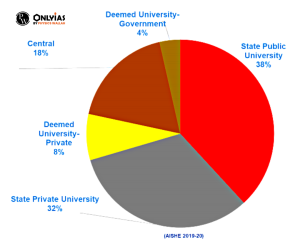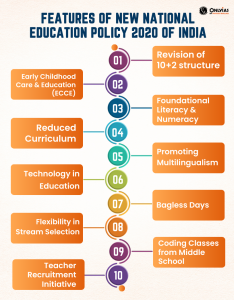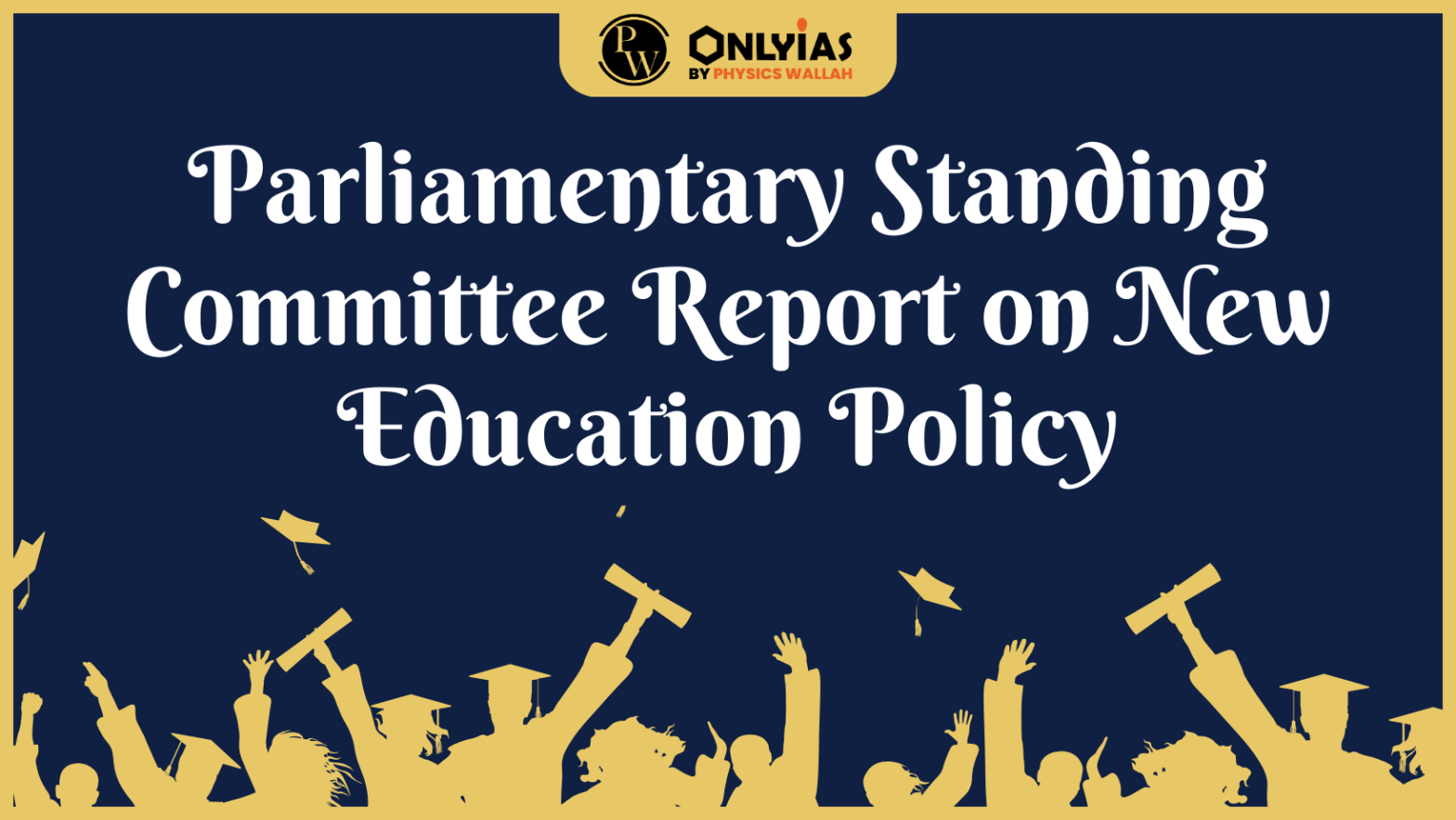Context:
New Education Policy Implementation in Higher Education: A Progress Report
- The report assesses the salient features of the New Education Policy’s implementation in the higher education sector and the progress made so far.
- The Department of Higher Education, Ministry of Education has informed that there are a total of 1043 Universities in the country at present.
- Out of which 70% are governed under the State Acts, 18% are governed by the Central Government.
- It has further been informed that 94% of students are enrolled in State/private Institutions while 6% are enrolled in Central Institutions.
- There has been a gradual increase in the Gross Enrollment Ratio (GER) for all students and it has risen from 24.1% in 2016-17 to 27.3% in 2020-21.
- Further observes that GER for ST and SC students has also risen from 2016-17 to 2020-21.
- The details of break-up of Universities are given in pie-chart:-

About National Education Policy
-
- Background: The Ministry of Human Resource Development (MHRD) had constituted a Committee for drafting the new education policy (Chair: Dr. K. Kasturirangan) in June 2017.
- The NEP replaces the National Policy on Education, 1986.
- Emphasis: The NEP 2020 lays particular emphasis on the development of the creative potential of each individual.
- Principle: New education policy is based on the principle that education must develop the foundational capacities of literacy and numeracy and higher-order cognitive capacities, such as critical thinking and problem solving and also social, ethical, and emotional capacities and dispositions.
- Various steps taken to reform education in India:
- Radhakrishnan Committee
- Kothari Commission
- T.S.R. Subramanium Committee
- Kasturirangan Report (Drafted NEP)
New Education Policy 2020 Implementation: Transforming Higher Education in India
- Fruitful Progress: Through various appreciable measures like PM Schools for Rising India (PM SHRI), e-VIDHYA, NIPUN Bharat etc. the implementation of the new education policy 2020 is progressing on course with its vision to transform the higher education system to be more inclusive, flexible, and aligned with global standards.
- Best Practices– Jammu and Kashmir (J&K): The UT of J&K is one of the first in the country to implement NEP 2020 from the academic session 2022 in all the Higher Education Institutions.
- Introduction of “Design Your Degree” based on Choice Based Credit System(CBCS) launched by Jammu University under which students will be offered an opportunity to craft a personalised, interdisciplinary learning experience.

- Focus on Creativity: New education policy 2020 places thrust on developing a student’s ‘Creative Potential’ based on higher-order cognitive capacities and cultivating innovation and creativity in learners through industry-institution linkages and collaborative programs which will transform India into a vibrant knowledge society.
- Internationalisation of Education: Freedom being given to Indian universities to set up campuses in other countries and initiate start-up incubation centres and from among the top 100 universities in the world will be facilitated to operate in India.
- G20 New Delhi Declaration: Supported promoting open, equitable, and secure scientific collaboration and encouraging mobility of students, scholars, researchers and scientists across research and higher education institutions.
- Implementation of the Multi Entry and Multiple Exit (MEME) options within the framework of the New Education Policy (NEP) is a vital component of NEP 2020, offering students greater flexibility and choice in their educational pathways.
Issues Associated with New Education Policy:
- Multiple Entry And Multiple Exit (MEME): Indian institutions are likely to face several issues in implementing the MEME system under the new education policy.
- According to the report, while the MEME looked like a flexible system, which was being operated by Western educational institutions effectively, it might not work well in the country.
- Role of State: Rashtriya Uchchatar Shiksha Abhiyan (RUSA) Scheme aims to provide strategic funding to eligible state higher educational institutions. Strategic funding to higher educational institutions based on critical appraisal of State’s plans.
- Accessibility: Limited access to higher education in socio-economically disadvantaged areas due to financial barriers, geographical constraints, stereotype threat faced by students of marginalised sections etc.
- Linguistic Issues in New education policy: Most of the HEIs primarily use English as a medium of instruction and there is a lack of HEIs that teach in local languages. This leads to exclusion of non-english speakers, cultural and regional disconnect, and exacerbation of economic disparities.
- Lack of Funding: Public investment in the Education sector needs to reach 6% of GDP at the earliest. According to the Economic Survey 2022-23, total education outlay added up to 2.9% of the GDP.
Also read: India’s GDP Growth Rate: India GDP Growth Rate, Trends and Analysis
National Curriculum Framework (NCF):
- As per the New Education Policy, 2020, following four NCFs will be developed:
- National Curriculum Framework for Early Childhood Care and Education (NCFECCE)
- National Curriculum Framework for School Education (NCFSE)
- National Curriculum Framework for Teacher Education (NCFTE)
- National Curriculum Framework for Adult Education (NCFAE)
|
Way Forward
- Fulfilment of Goals: By 2030, every district in the country should have at least one multidisciplinary HEI and that the GER in higher education, including vocational education, should be increased to 50% by 2035.
- Effective Funding: Higher Education Financing Agency (HEFA) needs to diversify its funding sources beyond government allocations and explore partnerships with private sector organisations, philanthropic foundations, and international financial institutions.
- Reviewing and adjusting the interest rates on loans provided by HEFA can make them more competitive and affordable for HEIs.
- Patent Filing: There is steady progress in the field of higher education and specific impetus is required to be assigned to factors like anusandhan (research), that can help the country’s ranking in patent filing.
- Digitisation of Education: Various steps are taken to promote the use of digital technologies in education, including the development of digital libraries & SWAYAM PRABHA portal.
- The creation of a National Educational Technology Forum (NETF) can go a long way in expansion of digital infrastructure to make the country a Global Knowledge Hub.
- Adopting and harnessing the power of modern cloud based technologies can create a more efficient, transparent, and student-centric ecosystem.
- Student Involvement: Proper involvement of the student community, incorporation of their feedback and suggestions towards the changes proposed in new education policy, creating institutional mechanisms to handle student’s queries on issues such as the Academic Bank of Credits (ABC), MEME system can generate beneficial results.
- Inclusive Education: Implementation of certain specific initiatives aimed at enhancing access to education for marginalised communities in accordance with the New Education Policy 2020 through various initiatives like comprehensive awareness campaigns, infrastructure development, teacher training and recruitment, scholarship and financial support, digital inclusivity, etc.
- Ensuring Smooth Operation of MSME: Develop comprehensive guidelines including specific eligibility criteria, credit transfer mechanisms, and providing a clear roadmap for students pursuing different exit points.
- Implementation of a standardised Credit Accumulation and Transfer (CAT) system allows students to earn and transfer credits seamlessly across institutions.
- Improving the Impact of the Higher Education Financing Agency (HEFA): HEFA can consider diversifying its funding sources beyond Government allocations, explore partnerships with private sector organisations, philanthropic foundations, and international financial institutions to increase the available funds.
Conclusion
Successful implementation of New Education Policy can help in meeting the 4th Sustainable Development Goal (SDG), Education for all while ensuring equitable, inclusive and quality education for all by 2030.
| Attempt the Mains Question: New Education Policy 2020 is in conformity with the Sustainable Development Goal-4 (2030). It intends to restructure and reorient education system in India. Critically examine the statement. (GS Paper 2; UPSC Mains 2020) |
![]() 26 Sep 2023
26 Sep 2023

